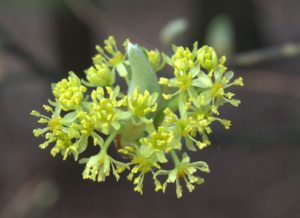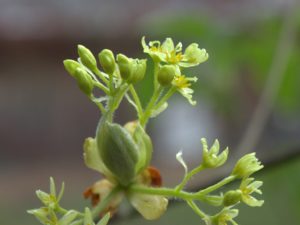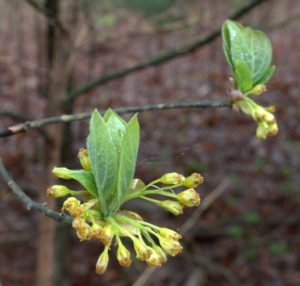Have you ever smelled a sassafras flower? They have the yummiest lemony-citrus scent. You might have to wait until next year by now, so put it on your list of things to do next April or whenever the trees are starting to grow their new leaves in your area.
Sassafras, Sassafras albidum, trees live in the Eastern United States. The trees are either male or female, so their flowers have different purposes and therefore different looks. It seems that the male trees out number the females because it took me a while to locate a female tree. It’s been a couple of years since I’ve even seen one.
(Photos taken 22 & 30 April 2016. Click on any image for a larger view.)

The female flowers seem simple compared to the male flowers which look rather bushy due to their nine stamens.
Female flowers appeared more symmetrical having six sterile stamens, which are short and fat compared to the male stamens but of the same golden yellow-orange color. Each stamen lies at the base of a pale yellow petal and they form a circle around the central pistil.

The pistil reminds me of a flower bud vase being bulbous at the base and having a tube that extends upward ending in a circular shape. The tip of the pistil appears white in this photo.
Flowers are held on long stalks that are retained during fruit formation so the fruits are borne on these stalks that measure an inch and a half long.
The flowers themselves are small and measure less than a half inch across.
The yellow flowers cluster at the branch tips and arise from a bud that also contains the developing leaves. A week later you can see the flowers are spent as they dangle around the growing leaves.

The blue, one-seeded fruits should ripen in late summer to early fall. The Peterson Guide to Eastern Trees states that wild turkey, bobwhite quail, songbirds and black bear will consume the fruits.
Thomas S. Elias in Grolier’s Field Guide to North American Trees adds squirrels and foxes to the list of critters that eat sassafras fruits. (It’s an out-of-print book, but available via Amazon’s book sellers. Way more information than Peterson’s Guide!)
Stay tuned to see if I can photo the berries before they’re all gone!